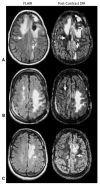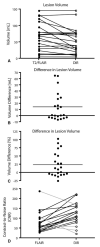Pre- and post-contrast three-dimensional double inversion-recovery MRI in human glioblastoma
- PMID: 23344788
- PMCID: PMC3616610
- DOI: 10.1007/s11060-013-1057-y
Pre- and post-contrast three-dimensional double inversion-recovery MRI in human glioblastoma
Abstract
Fluid attenuated inversion recovery (FLAIR) MRI sequences have become an indispensible tool for defining the malignant boundary in patients with brain tumors by nulling the signal contribution from cerebrospinal fluid allowing both regions of edema and regions of non-enhancing, infiltrating tumor to become hyperintense on resulting images. In the current study we examined the utility of a three-dimensional double inversion recovery (DIR) sequence that additionally nulls the MR signal associated with white matter, implemented either pre-contrast or post-contrast, in order to determine whether this sequence allows for better differentiation between tumor and normal brain tissue. T1- and T2-weighted, FLAIR, dynamic susceptibility contrast (DSC)-MRI estimates of cerebral blood volume (rCBV), contrast-enhanced T1-weighted images (T1+C), and DIR data (pre- or post-contrast) were acquired in 22 patients with glioblastoma. Contrast-to-noise (CNR) and tumor volumes were compared between DIR and FLAIR sequences. Line profiles across regions of tumor were generated to evaluate similarities between image contrasts. Additionally, voxel-wise associations between DIR and other sequences were examined. Results suggested post-contrast DIR images were hyperintense (bright) in regions spatially similar those having FLAIR hyperintensity and hypointense (dark) in regions with contrast-enhancement or elevated rCBV due to the high sensitivity of 3D turbo spin echo sequences to susceptibility differences between different tissues. DIR tumor volumes were statistically smaller than tumor volumes as defined by FLAIR (Paired t test, P = 0.0084), averaging a difference of approximately 14 mL or 24 %. DIR images had approximately 1.5× higher lesion CNR compared with FLAIR images (Paired t test, P = 0.0048). Line profiles across tumor regions and scatter plots of voxel-wise coherence between different contrasts confirmed a positive correlation between DIR and FLAIR signal intensity and a negative correlation between DIR and both post-contrast T1-weighted image signal intensity and rCBV. Additional discrepancies between FLAIR and DIR abnormal regions were also observed, together suggesting DIR may provide additional information beyond that of FLAIR.
Figures






References
-
- Lima FR, Kahn SA, Soletti RC, Biasoli D, Alves T, da Fonseca AC, Garcia C, Romao L, Brito J, Holanda-Afonso R, Faria J, Borges H, Moura-Neto V. Glioblastoma: therapeutic challenges, what lies ahead. Biochim Biophys Acta. 1826:338–349. 2012. - PubMed
-
- Mouthuy N, Cosnard G, Abarca-Quinones J, Michoux N. Multiparametric magnetic resonance imaging to differentiate high-grade gliomas and brain metastases. J Neuroradiol. 2011;39(5):301–307. - PubMed
Publication types
MeSH terms
Substances
Grants and funding
LinkOut - more resources
Full Text Sources
Other Literature Sources
Medical

